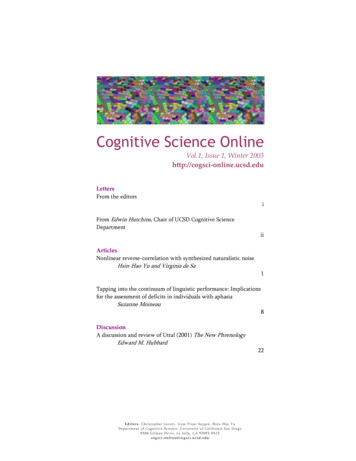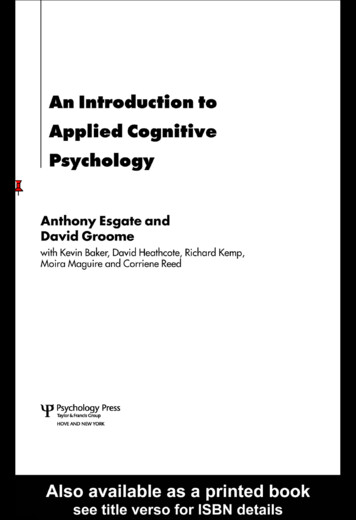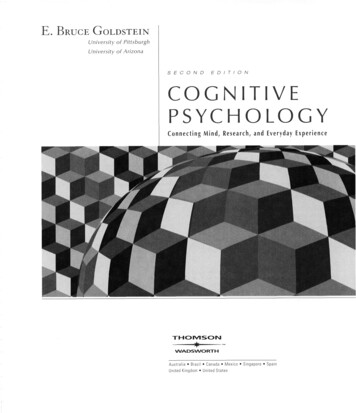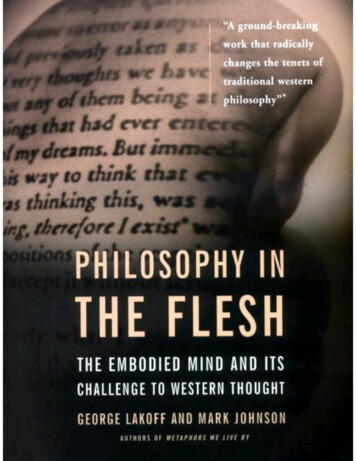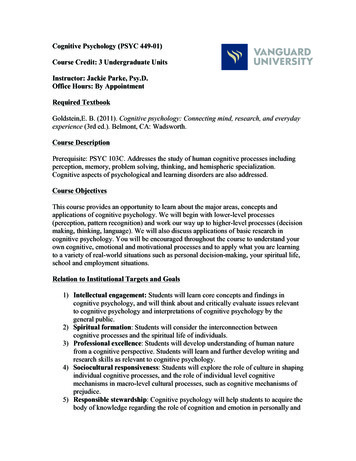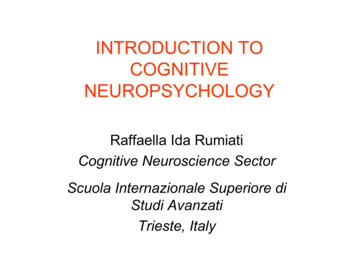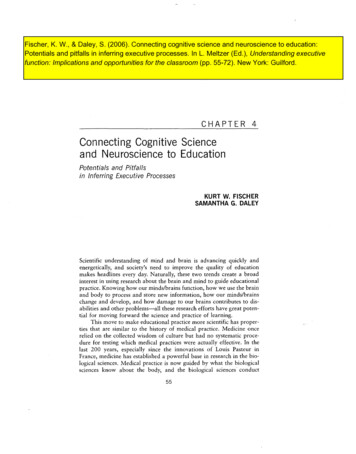
Transcription
Fischer, K. W., & Daley, S. (2006). Connecting cognitive science and neuroscience to education:Potentials and pitfalls in inferring executive processes. In L. Meltzer (Ed.), Understanding executivefunction: Implications and opportunities for the classroom (pp. 55-72). New York: Guilford.CHAPTER 4Connecting Cognitive Scienceand Neuroscience to EducationPotentials and Pitfallsin Inferring Executive ProcessesKURT W. FISCHERSAMANTHA G. DALEYScientific understanding of mind and brain is advancing quickly andenergetically, and society’s need to improve the quality of educationmakes headlines every day. Naturally, these two trends create a broadinterest in using research about the brain and mind to guide educationalpractice. Knowing how our minds/brains function, how we use the brainand body to process and store new information, how our minds/brainschange and develop, and how damage to our brains contributes to disabilities and other problems—all these research efforts have great potential for moving forward the science and practice of learning.This move to make educational practice more scientific has properties that are similar to the history of medical practice. Medicine oncerelied on the collected wisdom of culture but had no systematic procedure for testing which medical practices were actually effective. In thelast 200 years, especially since the innovations of Louis Pasteur inFrance, medicine has established a powerful base in research in the biological sciences. Medical practice is now guided by what the biologicalsciences know about the body, and the biological sciences conduct55
56THEORETICAL AND CONCEPTUAL FRAMEWORKSresearch that is informed by what is important to medicine. This processis interactive and reciprocal. Scientists do not dictate medical practice,but they contribute to investigating and understanding innovative treatments and techniques that often derive from the clinical skills and experiences of practitioners. In parallel fashion, education must clarify andstrengthen its relationship with the research disciplines that study development, learning, and the brain. This relationship should be a reciprocalone in which educational practice and scientific research inform andlearn from each other, as medicine and biology act symbiotically.Although this relationship is still emerging, the growth in knowledge of development, learning, and the brain already provides potentially productive connections between educational practice and scientificresearch. One particularly promising arena is analysis of possible generalabilities that are proposed as an important focus for educational practice, such as the teaching of executive function, the topic of this book.Based on both research and practice—scientific knowledge about howchildren learn and develop and the history of efforts in education toteach a broad, general ability—we will argue that there is no tightlyorganized executive function but only loosely coupled, diverse executiveskills. A closer relationship between educational practice and researchcan provide a more accurate and practically useful view of executivefunction and other candidates for general abilities, such as metamemory,metacognition, and theory of mind (Fischer & Immordino-Yang, 2002;Fischer, Immordino-Yang, & Waber, 2006).Commonly in human development and in learning in schools,researchers and teachers observe the regular occurrence of similar behaviors and changes that suggest a unified entity, such asexecutivefunction. —.- Careful research and practical observation f j allyfind that thesebehaviors are more diverse than unified. This widely occurring patternpervades all aspects of human learning and development, includingmotor functioning, cognitive development, and brain development, aswell as executive function. We argue that, like the other cases, executivefunction has important general characteristics that make it seem to be aunified entity, but at the level of detail important for educational practice it is diverse and variable, not unified. The practical implications ofsuch an interpretation are many.RECIPROCAL PARTNERSHIP: DEVELOPMENT,NEUROSCIENCE, AND EDUCATIONAOver the last two centuries, the biological sciences have come to form anatural partner for the improvement of medical practice. What fieldsmight play a similar role in relation to education? The complex nature of
Cognitive Science and Neuroscience57educational practice means that several types of research can produceeducationally usable knowledge (Fischer & Katzir, in press). In thischapter, we focus particularly on knowledge about human development,the learning process, and brain functioning.The study of how human beings develop and learn falls under theumbrella of the discipline of human development and its sibling, developmental psychology. This is the field of research that investigates howlearning takes place and how people change as they grow from infancythrough adulthood. Its research methods have traditionally involvedcontrolled experiments in laboratories as well as studies of naturallyoccurring changes in behavior with age and setting. Research questionshave often focused on narrow inquiries related to (1) normative patternsfor particular ages or social groups and (2) species-general human characteristics of thought, memory, attention, emotion, and learning. Thefield is now experiencing major efforts to move it toward a broaderframework that examines development as a function of the many components that affect human behavior, including biology, context, culture,and individual variation. Indeed, the first volume of the influentialHandbook of Child Psychology highlights this important shift in emphasis (Damon & Lerner, 2006).Neuroscience involves the study of the brain, especially its organization, functioning, and underlying physiology, including the neurons, synapses, and neural networks that it comprises. Neuroscience emphasizesbrain functioning but not necessarily outwardly noticeable behavior.Most questions in neuroscience focus on specific, experimentally tractable hypotheses about the brain’s response to simple stimuli (Turk et al.,2002). Study of the brain often requires combinations of fields in permutations such as cognitive neuroscience, behavior genetics, and behavioralneurochemistry. Our focus in this chapter is on research that makes connections between the brain’s activity and people’s actions and thoughts.Education is different from development and neuroscience, as it isnot only an academic area of study, but also a practical field. We consider education broadly to include traditional classroom learning, adultlearning, and informal learning activities.Education, human development, and neuroscience have yet toestablish a truly reciprocal partnership despite continually increasinginteractions tending in that direction. A handful of cases show the enormous potential of reciprocal interactions for benefiting educational practice. For example, research in dyslexia has led to major advances notonly in understanding the bases of specific reading disabilities, but alsoin the design of interventions to help students with dyslexia learn to readand write effectively. Maryanne Wolf and her colleagues (Wolf &Bowers, 1999; Wolf & Katzir-Cohen, 2001; Wolf, Miller, & Donnelly,2000) have developed a curriculum to support students with dyslexia
58THEORETICAL AND CONCEPTUAL FRAMEWORKSthat integrates knowledge from neuroscience, development, cognitivescience, and education in innovative and meaningful ways. David Roseand his colleagues use principles from these disciplines to inform thedevelopment of software and other educational tools that support reading, writing, and instruction that is flexible enough for a variety of learners, following the principles of what they call “universal design” (Rose,Meyer, Strangman, & Rappolt, 2002; Rose, Chapter 13, this volume).These are but two examples that show what is possible when expert scientists and educators from different disciplines work together to studyand inform educational activities.Such efforts move forward the reciprocal relationships of educationwith cognitive developmental science and neuroscience, producing majoradvances and innovations in educational practice. Yet caution remainsimperative in basing education-related decisions on basic research, especially when there are one-sided relationships rather than reciprocal partnerships. For example, concepts about executive function in cognitivescience have led to educational practices that are overly simple and donot engage the variability that teachers encounter every day with students in their classrooms.SIMILARITIES ACROSS DOMAINS: SIMILAR PATTERNSDO NOT SIGNIFY A UNITARY ABILITYIn a common type of unwarranted leap, researchers uncover similar patterns of behavior or brain functioning and assume that the similaritiesreflect a single underlying process or structure. The discovery of thesesimilarities, such as parallel patterns of learning or development, provides the basis for many important scientific discoveries, so researchersshould seek them, but the interpretation of the parallels requires caution:Even when the similarities point to some common process or function,they typically do not imply a unified or singular capacity, so implicationsfor educational practice are not simple (Fischer & Bidell, 2006). One ofthe most general characteristics of human functioning (both body andbehavior) is that many components operate mostly independently whileat the same time having some important links and similarities.In medicine, when a person experiences a sudden high fever, doctorsdare not assume that this symptom indicates a singular cause. A fevercan come from bacterial infection, viral infection, overheating of thebody, insufficient cooling of the body, malfunction of the immune system, and many other diverse causes. In every case, the body’s temperature regulation system is involved, but there is no single cause acrosscases. A veterinarian can build her practice on the understanding thatboth poodles and schnauzers are dogs, but she dare not assume that the
Cognitive Science and Neuroscience59various dogs are identical, or she will make critical mistakes in treatment. We will now discuss several examples of similarities in patterns ofbiological and cognitive development and then how to interpret the similarities and what the insights from these examples imply for analyzingexecutive function.Motor System(s)The motor system—the functions of the body that allow and controlmovement—can in many ways be viewed as a single entity. Like thedigestive system or the respiratory system, students tend to study themotor system as a unit. Understanding the functioning of muscles, tendons, ligaments, and the rest will provide a solid foundation for understanding how people can tap their toes, nod their heads, or throw abaseball. Given the common functions and the strong connections ofsome components, it makes sense to view the motor functions as a system.At the same time, the shared functions of the motor system do notmake it unitary or uniform, and assuming such a unity leads to criticalmisunderstanding. For example, an impairment or injury in one aspectof motor activity often has little or no influence on another aspect. Themotor system is highly differentiated into gross and fine motor activities,voluntary and involuntary muscles, distinct organs (arms, legs, heart,stomach, motor cortex, cerebellum, etc.) and even further specializedwithin each of these categories.Any basic anatomy and physiology textbook makes clear the complexity of the processes that enable human movement. In any one part ofthe motor system, such as muscles, crucial distinctions must be made.One textbook highlights the need to consider both differences and similarities among types of muscles (Marieb, 2006). There are three types ofmuscle tissue, which differ in cell structure, body location, and type ofstimulation to cause contraction, but all types have the same kinds of filaments that participate in contraction. In another piece of the motor system, different joints are capable of different types of rotation, each withdifferent implications for injury and treatment (Mader, 2005). Regarding how components work together, there are distinct categories thatspecify characteristic patterns of coordination, such as voluntary andinvoluntary movements and gross and fine motor skills.Viewing the motor system as a unified entity, then, is useful for analyzing how bodily movement happens, but the system is composed ofmany different parts and processes. It cannot be treated as a unitarystructure. The parts function independently in most ways, although theyare partly connected and coordinated. The same is true of behavioralsystems.
60THEORETICAL AND CONCEPTUAL FRAMEWORKSCognitive DevelopmentThe traditional view of development assumes that components thatshow similar growth functions involve the same unitary underlying process or capacity—a single stage of logic for Piaget’s (1983) theory or asingle buffer of short-term memory for classical information-processingviews (Case, 1974; Klahr & Wallace, 1976). This traditional view treatsdevelopment as a ladder on which people move upward step by step tosuccessively higher general cognitive stages in a linear fashion. An individual functions at a single general stage across domains and no longeruses earlier ones, according to this view. The stages on this metaphoricalladder assume a common state of development across all domains oflearning and behavior, from the ability to solve arithmetic problems tothe maturity to respond to social challenges. A S-year-old will show thesame (pre-operational) stage of cognitive development in arithmetic andsocial understanding, and an adult will show the same (formal operational) stage in both domains.People do not show this kind of consistency. Research strongly documents that the ladder metaphor is wrong when applied across domains(Fischer & Bidell, 2006), and any experienced teacher or observer ofchildren knows that students show different capacities in differentdomains. Only within a domain do children develop along a relativelyunified, consistent pathway.A dynamic view of development moves from the traditional ladderview to a different metaphor that includes both consistency and variability, consistent pathways within a domain and different pathways amongdifferent domains, Development proceeds along the strands of a web asshown in Figure 4.1. Each strand in the web represents a different specific domain of development. Depending on the breadth of the contentone chooses, the strands might represent broad domains such as motorskills, arithmetic knowledge, and literacy, or they might represent specific subdomains within a narrower domain such as simple arithmeticproblems, with addition on one strand, subtraction on another, and multiplication on a third. The strands in the figure specify domains in thedevelopment of executive processes. Development proceeds from the topof the diagram to the bottom, but a person can develop along differentstrands at different paces. While the ladder metaphor and the theorybehind it emphasize the normative commonalities in development acrossdomains, the web and the dynamic view capture variations in development across domains, as well as connections and separations (represented by intersections and branches).Besides this variability across domains of functioning, the web metaphor also allows for variability within domains for individual learners.A person working on a specific task does not stay fixed at one point on a
Cognitive Science and ejudgmentlearning comprehensionCCDCCD0-aBCDFIGURE 4.1. A developmental web for domains of executive function.strand but varies his or her activity depending on context and state(Fischer & Bidell, 2006; Fischer, Bullock, Rotenberg, & Raya, 1993). A1-year-old learns to walk on a level carpet inside the home but is unableto make a few steps across the grass in the backyard. Everyone has experienced situations such as being able in practice to remember lines for aplay or shoot a free throw and then failing with the same behavior in theperformance that matters. What does it mean to “know” material or tohave “mastered” a skill? On any particular task, a person acts at a widevariety of levels, ranging from the functional, or typical, level to the optimal level (what can be done with contextual support). The role of a supportive environment in causing variation along a strand in the web hasbeen widely documented for tasks as diverse as telling a story aboutsocial interactions or predicting whether objects will sink or float.The variability in behavior captured by the web helps illuminate theuniformity seen in some developmental changes. Children demonstraterapid changes in performance in specific age regions for optimal conditions in familiar domains-changes that have some of the properties ofstages. Such spurts have been documented in studies of, for example,
THEORETICAL AND CONCEPTUAL FRAMEWORKS62reflective judgment in adolescents and adults (Kitchener, Lynch, Fischer,& Wood, 1993) and use of pronouns in the early speech of Dutch children (Ruhland & van Geert, 1998), as shown in Figure 4.2. These spurtsand other kinds of discontinuities tend to cluster at particular ageregions for optimal performance, such as approximately 2 years forspurts in vocabulary, use of sentences, and pretend play. In Figure 4.1,look carefully at when the strands change direction, branch, or join, andyou will see that these discontinuities cluster in specific regions.People develop in spurts under optimal conditions, but typically notunder ordinary conditions, which lack contextual support and/or extensive familiarity and practice (Fischer et al., 1993). Figure 4.3 illustrates atypical pattern for development of optimal and functional (ordinary) levels in a domain such as reflective judgment or representation of socialinteractions. Skills develop in spurts for optimal level (high support, topline) but more slowly and smoothly for functional level (low support,bottom line). The same person shows both optimal and functional levels,which come and go with variations in contextual support and state. Inthis way, each person acts at multiple levels from moment to moment,even for a single domain (strand in the web), moving up and down within a range of skill levels as a function of support and state.When observers note only the spurts and other discontinuities,which cluster at a specific age region in the developmental web, they seewhat appears to be a single ability emerging at that age. Examined 100120140160Age in weeksFIGURE 4.2. Developmental spurt in pronoun use by Tomas, a Dutch boy.
Cognitive Science and Neuroscience63PAbstractsystemsAbS\e’J sentation systemsCo——— —SRpS\& ‘Rp2Rpl357g11131517ig21Age in yearsFIGURE 43. Optimal and functional levels in cognitive development. Skillsdevelop along a common complexity scale marked by a series of skill levels.With high support, they grow in spurts for optimal level. Without support, theygrow more continuously for functional level.broadly (in the whole web), this pattern becomes one regularity withinthe broader picture of variability. There is clearly no single, unitary ability emerging across all skills and domains at one age. Instead, a personbuilds skills along each strand, following its domain-specific developmental progression, and at certain points along the strand, spurts ahead.This spurt is a local process in the domain, not a shift in a single, unitarynew ability.Development is a complex phenomenon that encompasses both (1)elements of uniformity, such as regions of common change acrossstrands or domains, and (2) elements of individuality and variation. Aswith motor functioning, assuming unity neglects the variation that ispresent in cognitive development and, thus, oversimplifies and distortsthe nature of development, making it seem like a ladder. An accurateview of development must account for both uniformity and variability.The uniform aspects of cognitive development provide a valuableheuristic based on large-scale patterns of developmental change. Indeed,
64THEORETICAL AND CONCEPTUAL FRAMEWORKSthey have led to the identification of a general developmental scaleunderlying both cognitive development and learning (Dawson-Tunik,Commons, Wilson, & Fischer, 2005; Fischer & Bidell, 2006; Fischer &Immordino-Yang, 2002). At the same time, focus on only the uniformityleads to distortions, especially in education. The unitary view producesan emphasis on norms and a neglect of the variation that is inevitablypresent in educational settings. Children within a classroom will not allreach the same reading level at the same time, despite ladder-like viewsof reading that mark a text as at one specific grade level. This perspective makes individual variation appear abnormal and problematic ratherthan a phenomenon to be explored and explained. If a student is able tocomplete a page of algebra problems one day but seems to have forgotten everything the next day, the behavior appears abnormal and inexplicable (although sensitive teachers know to expect such variation). Withthe dynamic view of development, such variation is understandable andpotentially predictable from context and emotional state (e.g., Did heskip breakfast so he cannot concentrate today? Is a test next period causing anxiety? Did he have a supportive algebra lesson right before he didthe problems yesterday?).A dynamic view of development recognizes the similarities in development across different domains and simultaneously interprets them interms of the patterns of variation. This dynamic view is more useful andaccurate than a traditional view that assumes a unitary process becauseit deals directly with the complexities of human learning and action.Educators and developmental scientists working together can (1) illuminate the understanding of development by connecting it to variations instudents’ behaviors in schools and families and (2) simultaneously createresearch that feeds back to practitioners to help them use cognitive anddevelopmental analysis to facilitate learning and teaching in schools.Brain DevelopmentThe science of brain development is much less mature than that of cognitive development. Yet early evidence suggests that the model for cognitive development applies straightforwardly to important aspects of braindevelopment as well. Brain growth and cognitive growth seem to showthe same kind of web pattern and the same type of recurring growthcycle, with multiple developing strands and spurts and other discontinuides in growth along each strand. For instance, the part of the prefrontalcortex that supports working memory (holding information on-line for atime) develops separately from the part of the occipital cortex that analyzes visual information, although both develop with similar discontinuities (Fischer & Rose, 1996). (Scholars frequently nominate the prefrontal cortex as the key brain region for executive function.)
Cognitive Science and Neuroscience65The strongest empirical evidence of these brain growth patternscomes from research on the development of electrical activity in the cortex, measured through the electroencephalogram (EEG). The most studied property of the EEG is its energy (called “power”), which developsthrough fits and starts at specific ages that correspond to the ages ofemergence of optimal levels in cognitive capacity from infancy throughearly adulthood (Fischer & Bidell, 2006; Somsen, van ‘t Klooster, vander Molen, van Leeuwen, & Licht, 1997; Thatcher, 1994). Figure 4.4shows the results of one normative study (Matousek & Petersen, 1973)for the relative energy in the alpha band of EEG in the back of the cortex, with spurts and plateaus clearly evident at approximately 4, 8, 12,IS, and 20 years of age, apparently marking the cognitive levels that aremost relevant for the school years. Note the similarity to the growthcurve for optimal level in Figure 4.3.The similarity of growth curves for EEG energy and cognitive performance suggest a connection between development of brain andbehavior, but few studies have looked at brain and behavior concurrently to test the correspondence directly. For the current argument,assume that the correspondence is real—that growth spurts in the EEG80-70-60- 40 0100III5IIIIIIII10I15III120Age in yearsFIGURE 4.4. Development of relative power in alpha EEG in occipito-parietalarea in Swedish children and adolescents. The energy (relative power) in theEEG grows in spurts that parallel the pattern for optimal level in Figure 4.3. Thisgraph shows relative power in the occipital-parietal area of the cortex for thealpha band of the EEG in Swedish subjects (Matousek & Petersen, 1973).
66THEORETICAL AND CONCEPTUAL FRAMEWORKSindeed reflect brain reorganizations that relate to the new capacities thatemerge at specific ages. Even if this scientific hypothesis proves true,there are major issues about the implications for educational practice.Caution is required in drawing conclusions about the nature of learningand development.In the I970s and 1.980s, several American biologists and educatorsused evidence about age-related spurts in head circumference and EEGenergy, which they called “phrenoblysis” (Epstein, 1974, 1978) to drawconclusions about how schoolchildren learn (Fischer & Lazerson, 1984).They treated these conclusions as facts and used them to make extensiverecommendations to school boards, teachers, and parents. For example,the scholars went directly from theii findings about spurts in headgrowth and EEG to conclusions that when the head is in a growth plateau (a period of little change, not a spurt), no learning can occur. Theytold educators that instruction in new concepts should focus on periodsof growth because that was when new learning could occur. Yet therewas absolutely no research testing how learning related to periods ofbrain and head growth, and there was substantial evidence that childrenlearn new material at all ages during the school years, with no flat periods where learning does not occur.One reason for the popularity of these recommendations in education was that few educators knew much about the biology of the brain,so many of them simply accepted the claims of phrenoblysis as scientificfact. With stronger reciprocal connections between neuroscience, cognitive developmental science, and education, the scientists’ hypothesisabout the relation of spurts and plateaus to learning would have beensubject to empirical test before being used to make recommendations foreducational policy and practice.The model of phrenoblysis assumed that the brain and cognitionworked together as a unitary system instead of being composed of manyparts, most of which are only loosely coupled. Contrary to that assumption, development does not happen in a single process across all regionsof the brain, although there are important similarities in some aspects ofbrain development across many brain regions. An overly simple look atthe EEG evidence can lead to the conclusion that the entire brain isdeveloping during a growth spurt. In reality, development takes placealong separate strands (in a developmental web), and one of the goals ofneuroscientific research is to characterize relations among the growingstrands. Early evidence indicates that the growth process occurs incycles, moving systematically around locations in the brain, not as a single spurt at the same time across all brain regions (Thatcher, 1994). Theleft and right hemispheres seem to develop in different sequences, whichappear to repeat for each cycle of cortical reorganization (Fischer &
Cognitive Science and Neuroscience67Rose, 1996). Again, what at first appears like a unified process is in facta diverse set of individual processes acting in concert with each other.Scientists and educators can understand how the “system” works onlyby examining the parts and how they vary, which will eventually lead toan explanation of the neuroscientific principles of brain developmentand learning.Executive Function Is Not UnitaryExecutive function is typically conceived as a broad cognitive capacityand is subject to the same kinds of pitfalls in interpretation as other concepts about cognition and brain. The idea of a single, unified executivefunction falls into the same trap as concepts of unitary motor abilities,cognitive development, and brain development. The continuing lack ofconsensus regarding a definition of executive function arises in large partfrom the problems that result from treating it as a single, unitary cognitive ability. Teuber (1972) was one of the first to address the questiondirectly, in his article entitled “Unity and Diversity of Frontal LobeFunctions,” and a number of researchers have taken up the issue morerecently (Duncan, Johnson, Swales, & Freer, 1997; Miyake, Friedman,Emerson, Witzki, & I-Iowerter, 2000). As Baddeley (1996) puts it, thequestion remains whether it will “prove more appropriate to regard theexecutive as a unified system with multiple functions, or simply as anagglomeration of independent though interacting control processes”(p. 5).Analyses of executive function have taken positions of both unityand divergence and various stances in between. The Norman andShallice (1986) model of the control of action posits a relatively unifiedsystem during completion of non-routine activities. It posits two modesof control, one responsible for routine activities and one for non-routineones. Routine tasks are triggered whenever appropri
Connecting Cognitive Science and Neuroscience to Education Potentials and Pitfalls in Inferring Executive Processes KURT W. FISCHER SAMANTHA G. DALEY Scientific understanding of mind and brain is advancing quickly and energetically, and society’s need to improve the quality of education m


